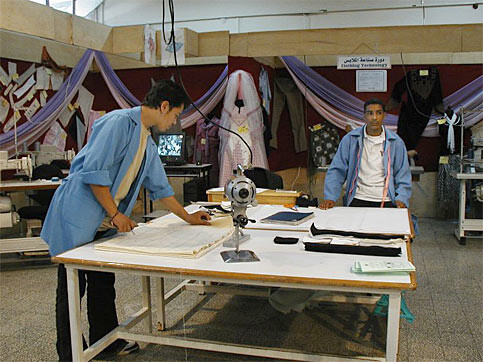UN Office for the Coordination of Humanitarian Affairs 19 August 2005

Palestinians learn new skills at an UNRWA run centre in Damascus. (IRIN)
DAMASCUS, 16 Aug 2005 (IRIN) - The continuing needs of thousands of Palestinian refugees residing in Syria have created new challenges, the Syrian General Authority for Palestine Arab Refugees (GAPAR) said at the opening of its annual conference in the capital, Damascus.
Management from GAPAR, along with representatives from the United Nations Relief and Works Agency (UNRWA) are attending the conference from 15 to 18 August to review refugee needs and achievements thus far, and to plan ahead.
According to GAPAR, the agencies will be focusing on the implementation of better infrastructure in the camps, including sewage systems, access to drinking water and maintenance of utilities.
GAPAR is the government department responsible for just over 400,000 Palestinian refugees, residing mainly in a total of 12 camps across the country with the majority in Damascus.
“They are treated on equal-footing basis with Syrian citizens in all life aspects, even though they retain the Palestinian citizenship,” noted the Director General of GAPAR, Ali Mustafa.
Patricia McPhillips, Officer-in-Charge of UNRWA affairs for Syria, commented, “The greatest of these challenges is improving living conditions for refugees, attaining access to quality free education, and ensuring healthcare and social services for all.”
She said there was a pressing need for additional space in refugee schools, as classrooms were overcrowded and up to 50 pupils per class were common.
Since 1950, UNRWA has been the main provider of basic education to Palestinian refugee children, offering nine years of schooling free of charge at almost 115 schools throughout Syria.
“UNRWA always suffers from financial constraints; hence, the agency cannot meet all needs of refugees,” McPhillips said.
The agency launched a medium-term plan early this year to enhance the ability of refugees to support themselves over the next five years.
One of the main projects involves moving some of the 5,000 families from the barracks at Neirab, in the city of Aleppo, to the nearby camp of Ein el-Tal.
“About five families live in each barrack under catastrophic conditions where basic services are not available, such as sewerage, drinking water and ventilation,” Mustafa explained.
Over the years the barracks - where the streets are no wider than the length of a child’s arms - have become more densely crowded and less hygienic, he said. Provision has been made for 300 families, or approximately 1,500 people, to be transferred voluntarily by the end of 2006.
“Last year 28 Palestinian families moved from Neirab to new flats in Ein el-Tal camp,” Mustafa noted.
The barracks area will be rehabilitated for the remaining refugees, according to UNRWA.
Most of the Palestinian refugees who fled to Syria after the 1948 Arab-Israeli conflict were from Zefat (Safad) in northern Palestine and the coastal cities of Haifa and Jaffa.
Related Links